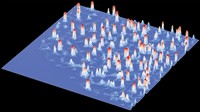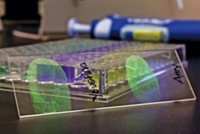Advertisement
Grab your lab coat. Let's get started
Welcome!
Welcome!
Create an account below to get 6 C&EN articles per month, receive newsletters and more - all free.
It seems this is your first time logging in online. Please enter the following information to continue.
As an ACS member you automatically get access to this site. All we need is few more details to create your reading experience.
Not you? Sign in with a different account.
Not you? Sign in with a different account.
ERROR 1
ERROR 1
ERROR 2
ERROR 2
ERROR 2
ERROR 2
ERROR 2
Password and Confirm password must match.
If you have an ACS member number, please enter it here so we can link this account to your membership. (optional)
ERROR 2
ACS values your privacy. By submitting your information, you are gaining access to C&EN and subscribing to our weekly newsletter. We use the information you provide to make your reading experience better, and we will never sell your data to third party members.
Analytical Chemistry
Pattern Recognition: A New Look At Old Forensics
by Carmen Drahl
September 10, 2012
| A version of this story appeared in
Volume 90, Issue 37

At last month’s Innocence Project symposium at the American Chemical Society meeting in Philadelphia, speakers explained that many traditional forensic disciplines lack scientific validation. Several researchers are examining those traditional fields with a quantitative lens.
COVER STORY
Pattern Recognition: A New Look At Old Forensics
For instance, quantum chemist Nicholas D. K. Petraco is working on a technique that, while not yet ready to be brought into a courtroom, might someday help associate a weapon such as a Glock pistol with crime scene evidence. The marks those pistols leave on cartridge cases—the part that holds gunpowder—are typically used by forensic experts to pair a cartridge with a gun. Petraco, of John Jay College of Criminal Justice at the City University of New York, uses computational pattern recognition and confocal microscopes to build three-dimensional models of striation and impression marks on cartridge surfaces (Scanning, DOI: 10.1002/sca.20251). Others are using Raman spectroscopy to link gunshot residue to ammunition (C&EN, May 21, page 36).


At the State University of New York, Buffalo, Peter J. and Mary A. Bush are part of a team that examines bite-mark analysis. The technique assumes each person’s bite mark is unique, but the field lacks data supporting this assumption. The Bush team is using statistics and tooth scans obtained from a company that makes mouth guards to examine whether individual tooth arrangements are unique (J. Forensic Sci., DOI: 10.1111/j.1556-4029.2010.01531.x). They’ve also borrowed a technique from paleontology and evolutionary biology that allows them to measure the extent of variation in the pattern a bite leaves behind (Forensic Sci. Int., DOI: 10.1016/j.forsciint.2011.03.028).
The team is using these indirect approaches for several reasons—including regulations from human subject research review boards. “You can’t just go out and bite a bunch of people,” Peter Bush says. The team places bite marks on research cadavers with casts of teeth mounted in a vise grip to precisely control bite pressure. But the model isn’t fully representative of bite marks at a crime scene. The researchers cannot replicate the violent altercation that goes along with the act of biting. The cadavers they use don’t retain all the properties of living skin. “But in science you have to start somewhere,” Peter Bush says. The results thus far, which have already been introduced in a handful of hearings, indicate that bite-mark analysis should be undertaken with caution because multiple suspects could have similar teeth.





Join the conversation
Contact the reporter
Submit a Letter to the Editor for publication
Engage with us on Twitter